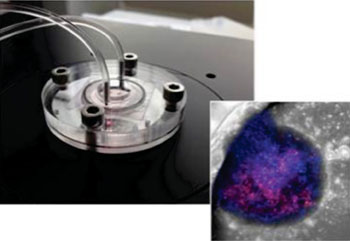Novel Microreactor Enables Evaluation of Drug Toxicity on the Liver
By LabMedica International staff writers
Posted on 27 Aug 2015
A novel three-dimensional microreactor capable of maintaining metabolically active liver cells in vitro for over 28 days under stable oxygen gradients that mimic the in vivo microenvironment of the liver was used to determine why the painkiller acetaminophen (paracetamol) causes damage to this organ.Posted on 27 Aug 2015
The liver tissue-based microreactor was the fruit of a project conducted by investigators at The Hebrew University of Jerusalem (Israel) and their colleagues at the Fraunhofer Institute for Cell Therapy and Immunology (Munich, Germany). The device was capable of maintaining the growth of liver cells under carefully controlled conditions for up to 28 days. Mitochondrial respiration was monitored using two-frequency phase modulation of phosphorescent microprobes embedded in the tissue. Phase modulation is focus independent and unaffected by cell death or migration.

Image: Liver-on-chip device and microscopic image of bionic liver (Photo courtesy of Dr. Yaakov Nahmias, The Hebrew University of Jerusalem).
The investigators reported in the June 4, 2015, online edition of the journal Archives of Toxicology that the device enabled the sensitive measurement of oxygen dynamics that revealed important information on the drug mechanism of action and transient subthreshold effects. Exposure to the widely used analgesic acetaminophen caused an immediate, reversible, dose-dependent loss of oxygen uptake followed by a slow, irreversible, dose-independent death. Transient loss of mitochondrial respiration was also detected below the threshold of acetaminophen toxicity.
It had been thought that liver toxicity was linked to acetaminophen's toxic byproduct NAPQI (N-acetyl-p-benzoquinone imine), which is normally produced only in small amounts and then almost immediately detoxified in the liver. However, under some conditions in which NAPQI is not effectively detoxified (usually in case of acetaminophen overdose), it causes severe damage to the liver. This becomes apparent three to four days after ingestion and may result in death from fulminant liver failure several days after the overdose. Results obtained with the liver bioreactor demonstrated the importance of tracing toxicity effects over time and suggested that NAPQI-independent targeting of mitochondrial complex III might be responsible for acetaminophen toxicity.
“The liver organs we created were less than a millimeter in diameter and survive for more than a month,” said senior author Dr. Yaakov Nahmias, professor of bioengineering at The Hebrew University of Jerusalem. “We realized that because we are building the organs ourselves, we are not limited to biology, and could introduce electronic and optical sensors to the tissue itself. Essentially we are building bionic organs on a chip. Because we placed sensors inside the tissue, we could detect small and fast changes in cellular respiration that nobody else could. Suddenly nothing we saw made sense.”
Related Links:
The Hebrew University of Jerusalem
Fraunhofer Institute for Cell Therapy and Immunology








 (3) (1).png)





